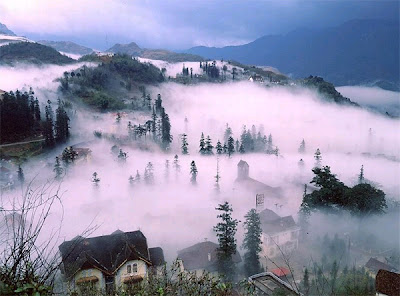Located 38km from Lao Cai City, Sapa is a mountainous district of Lao Cai Province.
And Sapa trekking tours is very well-known with Sapa Townlet, a beautiful and romantic resort.At the height of 1,600m above sea level, the average temperature of the area is 15-18°C. It is cool in summer and cold in winter.
The first thing you notice when approaching the resort town are some detached wooden mansions and villas perched on a hill top or hillside, behind thick pine forests and almost invisible on this foggy morning. Old and new villas with red roofs now appear and now disappear in the green rows of pomu trees, bringing the town the beauty of European towns.
Visitors apply Sapa tours will have opportunities to discover the unique customs of the local residents
Cat Cat village was founded since the 19th century and about 2km away from the centre of SaPa town. People are mainly Mong minority and often build houses spaced out dozens meters apart by mountain sides. They grow rice in terrace fields and maize on the mountain according to the handicraft cultivation method.Lao Chai Village About 8 – 9 Km southeast of Sapa town on the west bank of Muong Hoa River, Lao Chai is a commune composed by three large villages with over 100 families of the Black H’mong ethnic. From a high point of the main road 8 Km from Sapa town, great view of the whole village open wide to offer the marvelous panorama of the village, backed by high mountains and facing the river. The H’mong people in this village experience rice intensive farming on the lower land near the bottom of the valley as main source of earning while growing corn on the mountain slopes at the back of the village.Ta Van is a small village set within a picturesque valley not far from the northern Vietnamese mountain resort of Sa Pa. The area is renowned for its colourful ethnic minorities, and Ta Van is home to two such groups. A stay with one of the farmer families here will give you a close-up experience of the life-style and culture typical of the area. Trekking in the surrounding area is most satisfying.Giang Ta Chai Village Opposite to Su Pan on the other side of Muong Hoa River and valley is Giang Ta Chai village of the Red Zao ethnic, nested under shade of the trees and bamboo hedges near a large and magnificent waterfall.
Within only 2 days, this journey will bring you a brief understanding of Sapa and its tribal peoples while enjoying its fascinating scenery, paying visit to Sapa town and 3 tribal villages of Black H’mong and Zay peoples which is well-known for its breathtaking scenery. You will spend 2 nights on the train in 4 bed cabin with air-conditioning and 1 night at hotel in Sapa.
From : http://vietnam-halong-cruises.blogspot.com
The first thing you notice when approaching the resort town are some detached wooden mansions and villas perched on a hill top or hillside, behind thick pine forests and almost invisible on this foggy morning. Old and new villas with red roofs now appear and now disappear in the green rows of pomu trees, bringing the town the beauty of European towns.
Visitors apply Sapa tours will have opportunities to discover the unique customs of the local residents
Cat Cat village was founded since the 19th century and about 2km away from the centre of SaPa town. People are mainly Mong minority and often build houses spaced out dozens meters apart by mountain sides. They grow rice in terrace fields and maize on the mountain according to the handicraft cultivation method.Lao Chai Village About 8 – 9 Km southeast of Sapa town on the west bank of Muong Hoa River, Lao Chai is a commune composed by three large villages with over 100 families of the Black H’mong ethnic. From a high point of the main road 8 Km from Sapa town, great view of the whole village open wide to offer the marvelous panorama of the village, backed by high mountains and facing the river. The H’mong people in this village experience rice intensive farming on the lower land near the bottom of the valley as main source of earning while growing corn on the mountain slopes at the back of the village.Ta Van is a small village set within a picturesque valley not far from the northern Vietnamese mountain resort of Sa Pa. The area is renowned for its colourful ethnic minorities, and Ta Van is home to two such groups. A stay with one of the farmer families here will give you a close-up experience of the life-style and culture typical of the area. Trekking in the surrounding area is most satisfying.Giang Ta Chai Village Opposite to Su Pan on the other side of Muong Hoa River and valley is Giang Ta Chai village of the Red Zao ethnic, nested under shade of the trees and bamboo hedges near a large and magnificent waterfall.
Within only 2 days, this journey will bring you a brief understanding of Sapa and its tribal peoples while enjoying its fascinating scenery, paying visit to Sapa town and 3 tribal villages of Black H’mong and Zay peoples which is well-known for its breathtaking scenery. You will spend 2 nights on the train in 4 bed cabin with air-conditioning and 1 night at hotel in Sapa.
From : http://vietnam-halong-cruises.blogspot.com


















